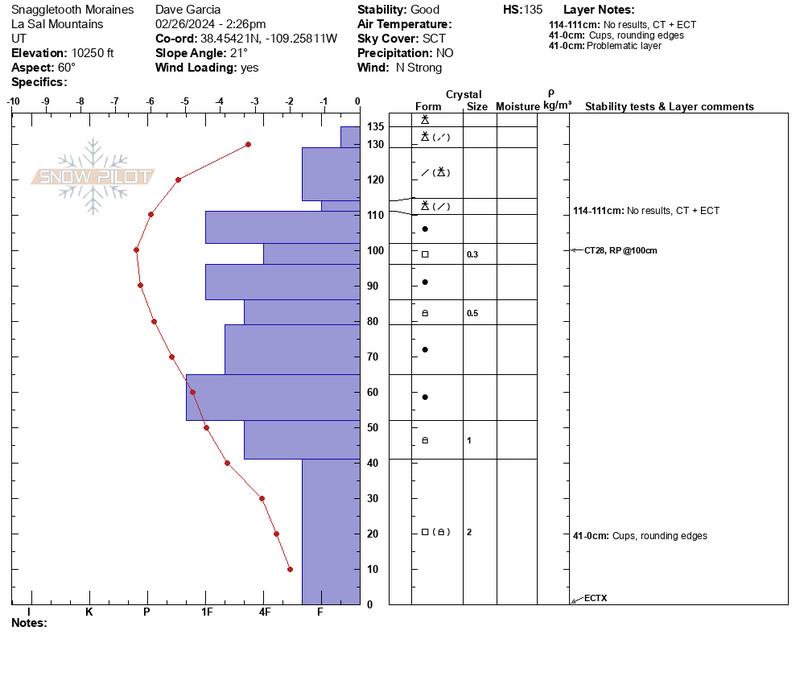
Eric Trenbeath
Forecaster
It’s now March and most years our deep, persistent weak layer (PWL) problems are usually turning the corner meaning they have gained strength, or are deeply buried by a strong, overriding snowpack, or both. This is the time of year when we usually start setting our sights on bigger lines once new and wind drifted snow instabilities have settled out. So, what’s going on this season? Why do we remain concerned about weak, faceted snow at the base of the snowpack, and what’s it going to take for those concerns to go away?
To be clear, we are in a “low probability, high consequence situation.” This means you are unlikely to trigger a deep and dangerous avalanche, but the possibility remains, and if you do, it’s going to be devastating. There are many slopes out there that you can likely get away with skiing or riding, but do you want to just get away with it? Dave and I both love to ski, and we love to ski big lines even more. But we don’t want to just get away with it. We want to know that it’s good to go, and there still remains too much uncertainty about it to risk our lives. Here are the things that continue to give us pause:
- Up to 60 cms of faceted snow still remains at the base of the snowpack. Although facets are showing signs of strengthening including rounding and greater density (4f, 4f+), particularly between 40 and 60 cms, many locations still harbor fist (F) hard, loose facets from 0-40 cms.
- The overall depth of the snowpack remains quite shallow, averaging between 130-170 cms so in most areas, a meter or less of snow is resting on top of the faceted weak layer. A person’s weight can fairly easily be transferred through a meter or less of snow.
- The last major storm cycle (three weeks ago) produced widespread natural activity down to this weak layer with two, relatively moderate snow loads. 11” at 1.4” of Snow Water Equivalent (SWE) between the night of Feb 1, and the morning of Feb 3, produced numerous deep, natural avalanches. A very large human triggered avalanche occurred on Feb 4, and another foot of snow between Feb 7-8 at just over 1.0” of SWE produced another round of natural activity down to the PWL.
With many slopes remaining that haven’t avalanched, along with the potential for repeat runners, we have to assume human triggered avalanches, failing on the PWL remain possible. In our favor, we obviously have time. More than three weeks have elapsed since the last deep avalanche occurred. It's also been that long since we received any significant snowfall. We also have generally non-reactive stability tests. But the weak layer remains, and the snowpack is still quite shallow. Therefore, we have a “low probability, high consequence scenario” with a fair amount of uncertainty surrounding it.
So, what’s it going to take for this problem to go away? What do we want to see before we can say with certainty that we feel good about it?
- A good dump! A decent load, on the scale of 2+ feet of snow, containing 2.0”-3.0” of SWE over a time period of a week or less would be a good test for this PWL. It would either produce another round of natural activity, or indicate that the weak layer can withstand the stress.
- Significant strengthening of the basal facets with densities of 4f to 4f+ throughout.
- A strong, cohesive, 1f slab of around 4’ or more in depth over the facets.
Until we see at least 1 out of 3 of these things happen, we’ll likely continue to advertise a “low likelihood, high consequence” PWL problem. One of those things has to happen before you'll see us biting off any big lines. If you have a higher risk tolerance, and you choose to venture into bigger terrain, you can minimize your risk by sticking to deeper snowpack areas; avoiding areas of steep, rocky, radical terrain; as well as slopes with complex terrain features including steep convexities, and blind break-overs. Choose your terrain accordingly and let’s hope that March delivers so we can put this thing to bed!

As long as we continue to find F hard facets like this at the base of the snowpack we've got a problem.



